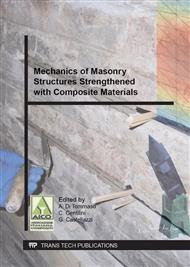p.526
p.534
p.542
p.551
p.559
p.567
p.575
p.584
p.595
Experimental Study on Masonry Panels Strengthened by GFRP: The Role of Inclination between Mortar Joints and GFRP Sheets
Abstract:
For the shear strengthening of masonry walls, different configurations for FRP sheets are currently used in real application, such as vertical, horizontal or diagonal strips. In the last configuration the FRP sheet is inclined with respect to the direction of mortar joints. In the experimental campaign presented in this paper, it is investigated whether the FRP-masonry bond could be affected by this inclination. In order to analyze this issue, three different typologies of masonry panels (with different textures) retrofitted by FRP sheets, inclined of 45 degrees with respect to the vertical axis of the specimen, are subjected to single-lap shear tests. Results of shear tests are presented in terms of maximum debonding forces, force-elongation curves, failure modes and strain profiles along the specimens. The use of Digital Image Correlation (DIC) technique allowed to obtain complete strain maps on the surface of the specimens tested, with the purpose of investigating possible variations in the strain field within the bonded area.
Info:
Periodical:
Pages:
559-566
Citation:
Online since:
September 2014
Authors:
Price:
Сopyright:
© 2015 Trans Tech Publications Ltd. All Rights Reserved
Share:
Citation:


